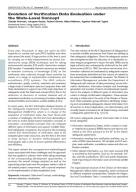Details
- Identification
- ISSN 1977-5296, DOI: 10.3011/ESARDA.IJNSNP.2018.9
- Publication date
- 1 December 2018
- Author
- Joint Research Centre
Description
Volume: 57, December 2018, pages 40-49
Authors: Claude Norman, Jacques Baute, Robert Binner, Mika Nikkinen, Agatha Walczak-Typke
International Atomic Energy Agency (IAEA)
Abstract: Every year, thousands of days are spent by IAEA inspectors in nuclear fuel cycle (NFC) facilities and other sites around the world. A large portion of this time is used for carrying out in-field measurements by various nondestructive assay (NDA) techniques and for taking environmental samples (ES) and/or destructive analysis (DA) samples. Comparably intensive resources are needed to maintain continuity of knowledge (CoK) on the verification data collected through these activities by means of a range of sophisticated containment and survei l lance (C/S) systems. The IAEA col lects, authenticates, quality controls, maintains and evaluates a large body of verification data and compares them with State declarations to support two of the main objectives of safeguards under the State-level concept (SLC), that is: the detection of diversion of nuclear material and of undeclared production or processing of nuclear material at declared facilities and locations outside facilities (LOFs).
In recent years, the NFC Information Analysis Section of the Safeguards Department Division of Information Management (SGIM-IFC), which is in charge of the evaluation of verification data, has been faced with a number of challenges: the first and most demanding is the need to evolve facility-based evaluation concepts to innovative, consolidated concepts that can integrate different types of information and support credible Statelevel safeguards conclusions, the second is the increasing volume and diversification of verification data to be evaluated given static resources, and the third is the need to keep abreast of modern methodologies and technologies with a view to ensure optimal effectiveness and efficiency.
This paper reviews the conceptual and methodological issues associated with these challenges and the approach that was applied to address them while taking advantage of the corresponding development opportunities. It presents the overall strategy adopted as well as the supporting project plan and the progress made to date in the related project components, with a special emphasis on the implementation of data visualization tools.
Keywords: evaluation; State-level Concept; methodology; diversion detection; visualization
Reference guideline:
Norman, C., Baute, J., Binner, R., Nikkinen, M., & Walczak-Typke, A. (2018). Evolution of Verification Data Evaluation under the State-Level Concept. ESARDA Bulletin - The International Journal of Nuclear Safeguards and Non-proliferation, 57, 40-49. https://doi.org/10.3011/ ESARDA.IJNSNP.2018.9

